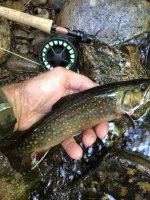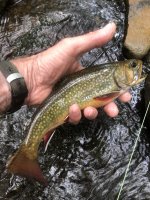pcray1231
Well-known member
TB, I can't say that I've EVER seen transparent pectoral, pelvic, or anal fins on brook trout. After seeing your post I went back and looked through a bunch of pictures of more typical 4-8" brookies, and same deal. No, none are transparent. None of them. I then went to google images and googled "wild brook trout", and again, no transparent pectoral, pelvic, or anal fins.
Browns and bows, yes. Not brookies. Though many of the tail (caudal) fins are semi-transparent.
There are varying degrees of red/orange/gray/black on the fins of different fish. It's by no means universal, but as a general rule of thumb, the wild ones show a lot more orange/red while the stockies show a lot more darker black/gray, even yellowish green if they look to be "attempting" some color.
From what I see, the white/black on the anal fin is, again, not universal, but about the most reliable indicator. Stockies generally have the white and black muddled together somewhat, or at least, it's not a straight line separating them, whereas the wild ones have a sharp straight line separating the white from the black.
In this thread, the only one that trips me up is Fishidiot's pic in post #58. It has that non-clear distinction between white and black on the anal fin. The black is bleeding into the white. Typical of a stockie, although, by no means as bad as I've seen. I find it quite possible this is a stockie that's been in the stream a long time, and hence starved out. But I'm certainly not sure of it.
Browns and bows, yes. Not brookies. Though many of the tail (caudal) fins are semi-transparent.
There are varying degrees of red/orange/gray/black on the fins of different fish. It's by no means universal, but as a general rule of thumb, the wild ones show a lot more orange/red while the stockies show a lot more darker black/gray, even yellowish green if they look to be "attempting" some color.
From what I see, the white/black on the anal fin is, again, not universal, but about the most reliable indicator. Stockies generally have the white and black muddled together somewhat, or at least, it's not a straight line separating them, whereas the wild ones have a sharp straight line separating the white from the black.
In this thread, the only one that trips me up is Fishidiot's pic in post #58. It has that non-clear distinction between white and black on the anal fin. The black is bleeding into the white. Typical of a stockie, although, by no means as bad as I've seen. I find it quite possible this is a stockie that's been in the stream a long time, and hence starved out. But I'm certainly not sure of it.





